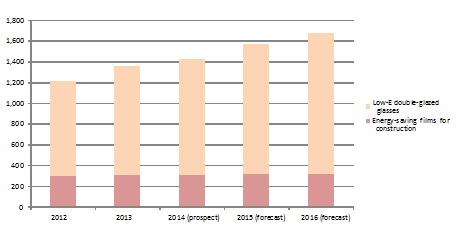Environmental-Friendly Energy-Saving Window Material Market in Japan: Key Research Findings 2015
Research Outline
- Research period: September 2014 to March 2015
- Research target: domestic manufacturers of window films and low-E double-glazed glasses
- Research methodologies: Face-to-face interviews by the expert researchers
<What are Environmental-Friendly Energy-Saving Window Materials? >
Environmental-friendly, energy-saving window materials in this research consist of window films for construction and low-E double-glazed glasses aiming for energy saving.
<What is Environmental-Friendly Energy-Saving Window Material Market? >
The environmental-friendly, energy-saving window material market in this research is calculated based on the total volume of products that were shipped to the domestic market and exported to overseas from domestic manufacturers.
Summary of Research Findings
- Environmental-Friendly Energy-Saving Window Material Market in 2014 is likely to achieve 14,250,000 m2, 105.2% of Size of Previous Year
The environmental-friendly energy-saving window material market, comprised of total shipment volume of window films for construction and low-E double-glazed glasses aiming for energy saving shipped to the domestic market and exported to overseas from the domestic manufacturers, is likely to attain 14,250,000 m2 in 2014, 105.2% of the size in the previous year. The market had once declined in 2012 due to reaction from the preceding year, but it turned to a rising tendency in 2013 and has constantly been keeping 5 to 10% of annual growth rate since then.
- With Chaotic Status Right After the Great Earth Quake Settled Down, Size of Energy-Saving Window Films for Construction Rising Slightly
The rapid expansion of demands for environmental-friendly energy-saving window films for construction in 2011 stemmed from power shortage caused by the great earthquake. Such situation encouraged people to put thin films on the building windows hoping to increase efficiency of air conditioner effects. The demands had bloated but quickly shrank by 2012. After such ups and downs, the market slightly turned to an upward tendency.
On the other hand, the window film manufacturers have developed the all-year-round products that improve efficiency of both air conditioners in the summer, but also of heaters in the winter. This triggered the manufacturers to sell a series of eco-products, including low-heat thermal transmission films. The domestic market of environmental-friendly energy-saving window materials for construction (including those that were shipped to the domestic market and exported to overseas) is expected to achieve 3,100,000 m2 in 2014, 101.6% of the volume in the previous year, among which 50,000 m2 applies to low-heat thermal transmission films, which rose by 11.1% from the precedent year.
- Point-Bestowing System for Energy-Saving Residences Expected to Raise Utilization of Low-E Double-Glazed Glasses Once Again
Influenced by the consumption tax increase, the market size of low-E double-glazed glasses in 2014 (including domestic shipment and export, based on the shipment volume from manufacturers) is expected to attain 11,150,000 m2, 106.2% of that in the precedent year. A point-bestowing system for energy-saving residences led by MLIT is to be in effect in 2015, which is likely to raise utilization of low-E double-glazed glasses once again and expand the market to attain 12,500,000 m2, 112.1% of the size of the previous year.
- Figure & Table 1: Transition and Forecast of Energy-Saving Window Material Market

